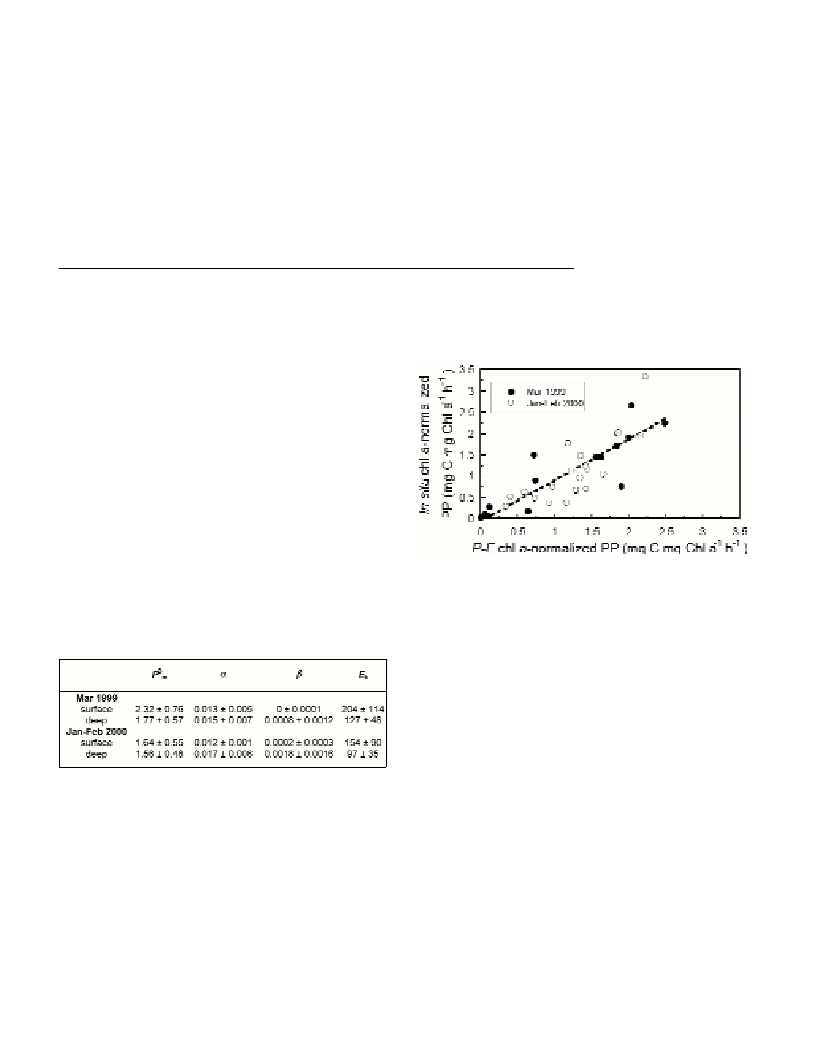Rapp. Comm. int. Mer Médit., 37,2004
281
WINTER PELAGIC PHOTOSYNTHESIS IN THE NW MEDITERRANEAN.
EVIDENCE OF HIGH PRIMARY PRODUCTION RATES
X.A.G. Morán
1*
and M. Estrada
2
1
Instituto Español de Oceanografía, Centro Oceanográfico de Xixón, Xixón, Spain - * xelu.moran@gi.ieo.es
2
Institut de Ciències del Mar, CMIMA, CSIC, Barcelona, Spain - marta@icm.csic.es
Abstract
Primary production in the NW Mediterranean was estimated in two cruises (Mar’99 and Jan-Feb’00) by means of in situincubations and
photosynthesis-irradiance relationships. Both approaches showed a good agreement. Photosynthetic parameters displayed differences
within the mixed layer, suggesting rapid photoacclimation. Phytoplankton assemblages were acclimated to lower irradiances during 2000.
Although a high variability was found between years, stations and visits, chlorophyll a-normalized rates were ~1 mg C mg Chl a
-1
h
-1
in
both cruises. Primary production rates were generally higher in 1999 than in 2000, ranging 326-1963 mg C m
-2
d
-1
and 124-868 mg C m
-
2
d
-1
, respectively. These results support the hypothesis of a late winter, rather than spring, maximum of primary production in the NW
Mediterranean.
Keywords: phytoplankton, primary production, photosynthetic parameters, NW Mediterranean, winter
The NW Mediterranean was sampled during the winters of 1999 (3-
13 March) and 2000 (29 January-10 February) in the HIVERN
cruises. We estimated primary production at 6 stations with the
14
C
technique using two methods, short-term in situincubations and
photosynthesis-irradiance (P-E) relationships. In situincubations
were performed with water collected from 8 depths down to 60 m. For
the P-Eexperiments, water was taken from 2 depths within the photic
layer (mostly 5 and 30 m) and incubated under an irradiance gradient
of ~2-2000 µmol photons m
-2
s
-1
. Photosynthetic parameters were
obtained with the model of Platt et al. (1). The depth profiles of
photosynthetically active radiation (PAR) and chlorophyll atogether
with the daily variation in surface PAR were used to estimate
integrated rates of primary production from photosynthetic
parameters.
Photosynthetic parameters (Table 1) indicated that phytoplankton
assemblages were acclimated to lower irradiances in 2000, as
expected from the earlier sampling. Photoinhibition was commonly
observed in deep samples. Alhough the parameters were differentially
affected in the two years most of them presented significant
differences between surface and deep values within the well-mixed
upper layer, suggesting that photoacclimation was faster than water
column mixing rates, as previously observed in the Alboran Sea (2).
Table 1. Mean (±SD) photosynthetic parameters in surface (5 m) and
deep (15-60 m) samples in the two cruises. P
Bm
: maximum chlorophyll
a-normalized photosynthetic rate (mg C mg Chl a
-1
h
-1
);
a
: initial slope
of the P-Erelationship [mg C mg Chla
-1
h
-1
(µmol photons m
-2
s
-1
)
-1
];ß:
photoinhibition paramenter (same units as
a
). E
k
: light saturation
parameter (µmol photons m
-2
s
-1
).
A good agreement was found between both methods of estimating
primary production. Fig. 1 shows the relationship between
chlorophyll a-normalized hourly rates at the depths of the P-E
experiments of all stations (n=35). The slope of the linear regression
(In situPP = -0.06 + 0.96 P-EPP, r
2
=0.68, p<0.001) was not
significantly different from 1.0 (t-test, p=0.28). Estimates of in situ
and P-E-derived integrated primary production rates were also
significantly correlated (r=0.85, p<0.001, n=16).
Surface phytoplankton biomass was a good estimate of integrated
primary production rate (r
2
=0.71). A high variability was found
between years, stations and consecutive visits, with relative increases
up to 9-fold, but integrated assimilation numbers were virtually the
same in both periods (1.07 ±0.37 and 0.99 ±0.45 mg C mg Chl a
-1
h
-1
, respectively), suggesting similar phytoplankton assemblages
and/or photoacclimation responses during the later winter months.
Due to later sampling, values were generally higher in 1999 than in
2000, with respective ranges of 0.3-2 g C m
-2
d
-1
and 0.1-0.9 mg C
m
-2
d
-1
. These values, particularly the 1999 ones, are considerably
higher than those available from other more intensively sampled
periods (3) and comparable to more productive systems, supporting
the hypothesis of a late winter, rather than spring, maximum of
primary production in the NW Mediterranean.
Fig. 1. Relationship between chlorophyll a-normalized primary
production rates obtained in in situand P-Eexperiments. Linear
regression explained in the text.
References
1-Platt T., Gallegos C.L., and Harrison W.G., 1980. Photoinhibition of
photosynthesis in natural assemblages of marine phytoplankton. J. Mar.
Res., 38: 687-701.
2-Morán X.A.G., and Estrada M., 2001. Short-term variability of
photosynthetic parameters and particulate and dissolved primary
production in the Alboran Sea (SW Mediterranean). Mar. Ecol. Prog. Ser.,
212: 53-67.
3-Estrada M., 1996. Primary production in the northwestern
Mediterranean. Sci. Mar., 60: 55-64.

